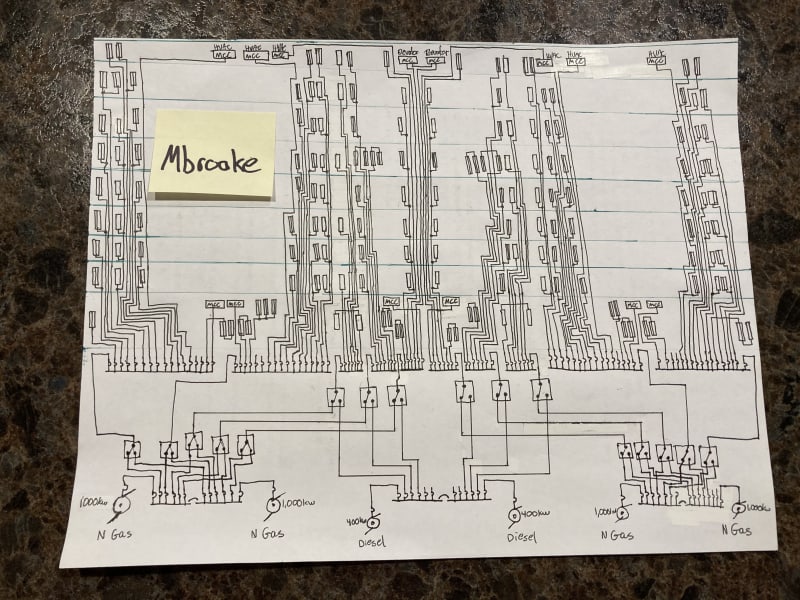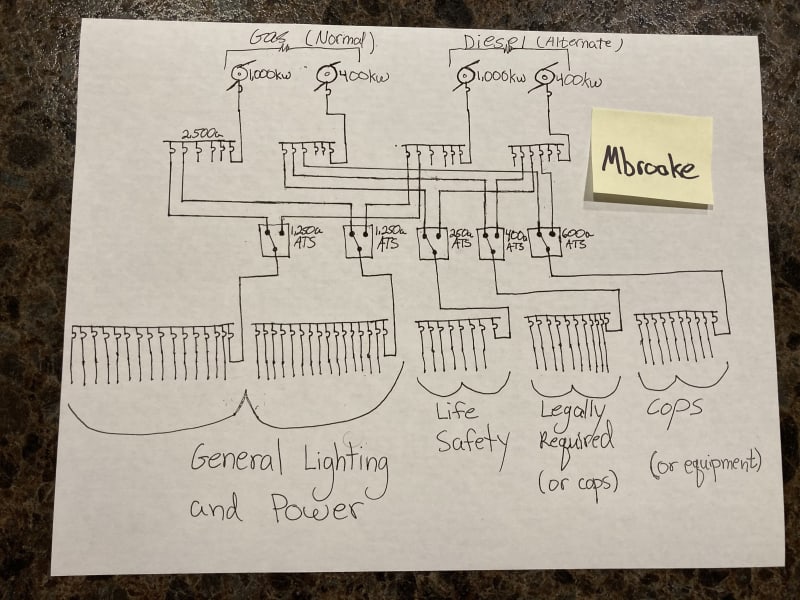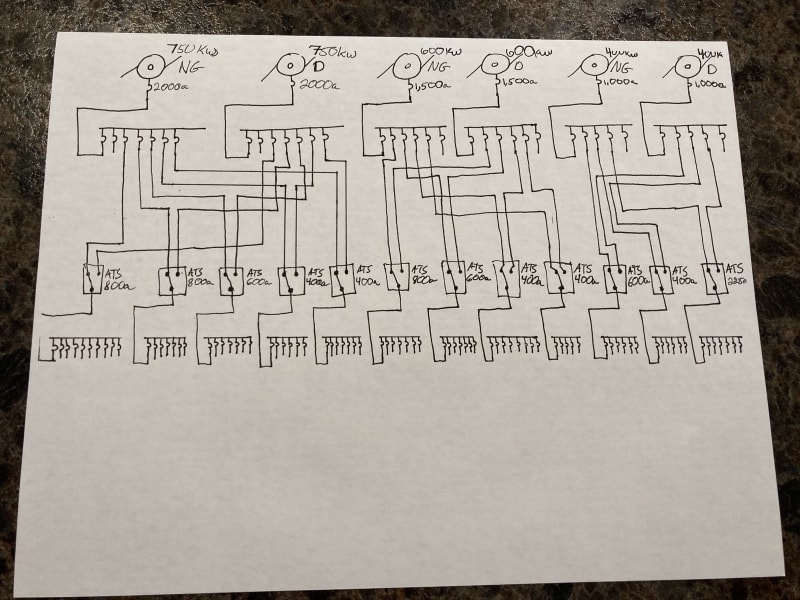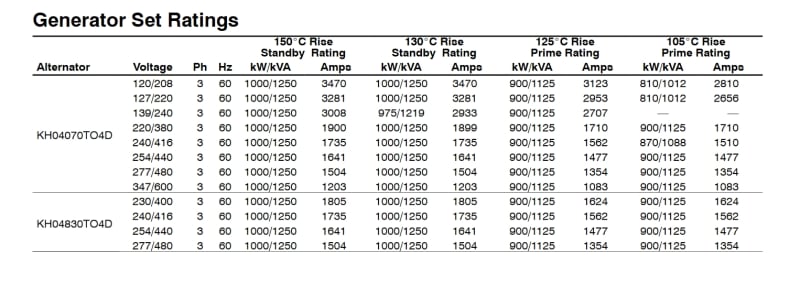Thanks Mbrooke for putting up with my pained sensibilities.
Nahh- I need someone to put this through the wringer so to speak. More minds are better than one

I'm still saying you don't really have N+1 capacity it seems more like N+3, too many excess generators.
KW capacity wise there is a lot more excess than if the gens were paralleled and of the duel fuel type. Sure. I will recognize this part.
You're still working the emergency generators, COPs (whatever they are), and life safety. The whole premise; its operational and cost complexity, can be dumped if you have a flat N+1 deployment.
Critical Operations Power System- see NEC article 708:
There is no need for emergency stuff in this case because the system isn't hooked to a POCO grid that they have no control over and can be lost for whatever reason.
Huh!?!
![[shocked] [shocked] [shocked]](/data/assets/smilies/shocked.gif)
Honestly, its statements like this which make me question the knowledge/experience/understanding of engineering in some of the members posting here. I only make this rebuttal on the basis that another member said I was entertaining- so I figure the discussion is open for tit for tat on both sides going both ways
![[smile] [smile] [smile]](/data/assets/smilies/smile.gif)
![[tongue] [tongue] [tongue]](/data/assets/smilies/tongue.gif)
But, I'm glad you said this. I think this where a lot of the disputes in this thread are originating from. A lack of understanding in regards to code, critical power and not having all your eggs in one basket.
There is very much a need for emergency stuff:
1. Article 700 of the NEC (along with NFPA 101 and driven by pother applicable building codes / AHJs) still require life safety systems in buildings even when supplied by an off grid system.
2. The Normal source of power can fail for a variety of reasons, in a variety of ways even when fed from a co-gen.
3. Article 700 requires separate circuits reasonably protected from fire in regards to emergency egress lighting where as normal power does not have this requirement.
Granted in remote construction or government project you might be able to pick and chose what codes apply, if any, but do you really want to put people at risk? Do you really want a fire taking out the normal power system leaving an 8 story building pitch black to the point people can't find stairwells let alone be able to walk down them to get out?
As an OFF-Grid facility there is no reason to ever have it all go down unexpectedly.
Not when you are paralleling everything into a single piece of gear.
You have hot standby that can come online faster than an emergency generator. Hence no emergency circuits, no life safety, no COP.
I know plenty of places with parallel power production that can take over when the utility drops out without so much as a blink. Does that mean hospitals in these cases can ditch all the extra conduit, wiring, runs, isolation, dedicated rooms, dedicated shafts, panels, ATSs, ect for the separate branches? Required by code as a means to create redundant diversity and so a fault on one branch does not take out the other?
I hear your concern about gear size, but. Every other non-off grid place has one incoming buss from the POC and it gets distributed in the standard every-one-does-it way. They wouldn't have a butt-load of ATS, Probably not a single one.
So based on what you said:
...there is no reason to ever have it all go down unexpectedly.
The main bus will never fault? And be protected from fire? As well as all the other unprotected runs through out the facility?
This place should be built the same way. Plan it like the power is from a POCO then build a power plant and connect it to the standard industrial structure.
Ummm- if I was to plan this as if from the POCO I still need at least 3 ATS for life safety, legally required and COPs load.
Re-read what you wrote, at first you said I would need emergency circuits if only fed from a POCO, but are now telling me to design as coming from a POCO.
Doing this allows complete freedom in the future to supply power anyway they want it. Co-Gen, solar, wind, walkaway nuke, maybe the grid even shows up. It all comes in thru the same portal. The existing generation can augment whatever's available. Maybe solar can supply 70% during the day. Drop off 2 prime-movers. Add one when the sun goes down. Maximum flexibility from the get-go. Consider these contingencies in your N+3 design, they'd be so painful as to be non-starters.
Having a flat design means you could have one generator running at 3am. The above design can never have less than 3 generators running 24 hours a day. That can't be as cost effective.
I'll give you that- the gas units will see low load levels at night during cool weather periods. This is where I need to really think about paralleling or just accept poor fuel economy.





![[lol] [lol] [lol]](/data/assets/smilies/lol.gif)
![[bigsmile] [bigsmile] [bigsmile]](/data/assets/smilies/bigsmile.gif) (from the green color).
(from the green color).

![[shocked] [shocked] [shocked]](/data/assets/smilies/shocked.gif) Honestly, its statements like this which make me question the knowledge/experience/understanding of engineering in some of the members posting here. I only make this rebuttal on the basis that another member said I was entertaining- so I figure the discussion is open for tit for tat on both sides going both ways
Honestly, its statements like this which make me question the knowledge/experience/understanding of engineering in some of the members posting here. I only make this rebuttal on the basis that another member said I was entertaining- so I figure the discussion is open for tit for tat on both sides going both ways ![[smile] [smile] [smile]](/data/assets/smilies/smile.gif)
![[tongue] [tongue] [tongue]](/data/assets/smilies/tongue.gif)